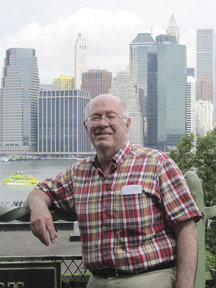Historian Randall Gabrielan knows it may not be possible to cram the entire history of Hoboken into one book, but his newest text “Hoboken – History and Architecture at a Glance” comes mighty close.
“There are a number of books about Hoboken, but this one is purposely designed, planned, and written to do something the others haven’t: Show the vast and deep scope of Hoboken history brought up to date,” Gabrielan said. “So much of what’s important in Hoboken’s history is happening right now.”
The book contains hundreds of clear, detailed photographs from different eras of Hoboken life. The photographs come courtesy of a collection of various contributors, as well as from the Hoboken Public Library. Gabrielan brings the reader back to the 17th century, and then quickly to a recent history in his detailed introduction.
“Hoboken claims an origin that pre-dates the 1660s settlement of New Jersey, which stems from the 1630 De Pauw purchase from the Indians of a vast regional expanse that included the future Hoboken,” Gabrielan writes in the introduction.
“My contact with Hoboken was extremely little until I decided to take a look around when going to Jersey City on New Jersey Transit.” – Randall Gabrielan, historian
________
Jersey City native
While the book may appear to be written by someone who has seen Hoboken change through his own eyes, Gabrielan did not have much experience with the city before he began writing his newest text. Gabrielan was born and raised in neighboring Jersey City, but said it wasn’t common for him to venture into Hoboken.
“If you were in Jersey City, you didn’t go to Hoboken, and if you were from Hoboken, you didn’t go to Jersey City, unless you had a relative there,” he said. “My contact with Hoboken was extremely little until I decided to take a look around when going to Jersey City on New Jersey Transit.”
Gabrielan now lives in Middletown, N.J. with his wife, Carol T. Stout, and their golden retriever, Roland.
“I discovered that there is a great and exciting city right behind the terminal,” he said. “That’s what drew me into the city and ultimately into writing the book.”
‘The old and the new coming together’
Gabrielan said certain parts of Hoboken life “wowed” him, specifically the “old, well-preserved structures.”
The book took three years to complete.
One chapter of the book focuses on not only Stevens as the university, but also the history of the Stevens family.
“You can’t do justice to Stevens and how important they were [to the city],” Gabrielan said. “They shaped the look of the city for a period long after they were gone from the city.”
Gabrielan said it’s difficult to pinpoint a particularly favorite chapter, but said he enjoyed working on the east side of town.
His favorite area of Hoboken is “probably the area around the terminal.”
“A few blocks in either direction north or west you can see the old and the new coming together, starting with the terminal,” he said. “It’s a great terminal and it’s a survivor of several transportation centers that were up and down the shore.”
The book also focuses on different aspects of Hoboken life, such as in chapter 2, titled “Hoboken as a Transportation Center” and chapter 3, “The Terminal Environs.”
36th book
Hoboken isn’t the first city Gabrielan has profiled in a historical book. In fact, Gabrielan is the author of “Jersey City: A Monumental History” which was published in 2007. He has also focused on his current hometown, Middletown, in a 2008 text.
Gabrielan believes Hoboken is a very unique city, calling it “one of the most historic places in New Jersey.”
Gabrielan has also published texts about Red Bank, Tinton Falls, Colts Neck, Long Branch, Keansburg, Atlantic Highlands, Monmouth, Sea Bright, and Rumson,. He has written a total of 36 books, and has been commissioned to write histories of private organizations as well as various municipalities. His first book was published in 1994.
The book “Hoboken – History and Architecture at a Glance” is available at the Hoboken Historical Museum, and will soon be available in the City Discount store at 207 Washington St. The book is also available online at sites like Amazon.com.
Gabrielan is traveling to the Hoboken Historical Museum to deliver a speech “The Lure of the City: Hoboken History and Architecture at a Glance” on March 20 at 4 p.m. The museum is located at 1301 Hudson St. The suggested donation for the speech is $5, but museum members can attend for free.
Ray Smith may be reached at RSmith@hudsonreporter.com
